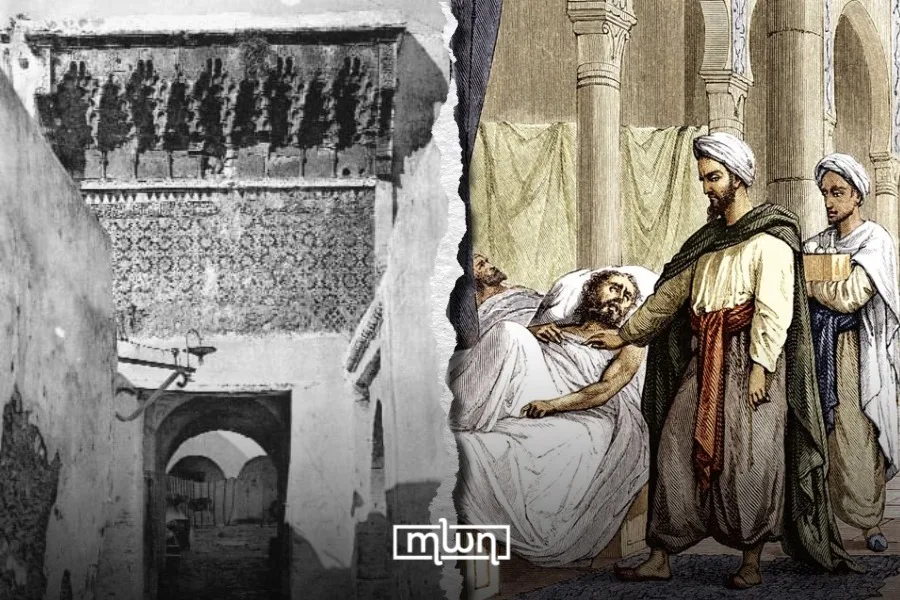Marrakech once housed a hospital so advanced that chroniclers claimed there was nothing like it in the world.
Fez – When Sultan Abu Yusuf Yaqub al-Mansur decided to build a hospital in Marrakech in the 12th century, he wasn’t just erecting a medical facility, he was setting a standard for healthcare centuries ahead of its time.
Known as the Marrakech Bimaristan, this institution became one of the finest examples of medieval medicine in North Africa, combining science, architecture, and humanity in a way that still astonishes historians today.
Built during the height of Almohad power, the hospital was designed not as a modest treatment center but as a palace of healing.
Al-Mansur ordered skilled builders to craft it with precision and elegance, filling its courtyards with fruit trees and fragrant gardens, channeling water through its halls, and decorating its walls with intricate carvings.
Historical accounts even describe marble basins at its heart and rooms furnished with fine wool, silk, and leather.
Beyond physical, biological health
This was not a cold, austere hospital; it was a place designed to restore health and dignity.
Marrakech Bimaristan operated with an impressive level of organization. It was divided into two separate sections for men and women, each equipped with its own staff, facilities, and supervisors.
Within these wings, patients were further grouped according to their illnesses. There were rooms for internal diseases, eye disorders, broken bones, fevers, chills, and digestive ailments, an early form of medical specialization long before the term existed.
Each department had its own chief physician, while the entire institution was overseen by an official known as the “Saour al-Bimaristan.”
Pharmacists prepared medicines, ointments, and syrups on-site, ensuring treatments were readily available.
Patients were even given seasonal clothing and bedding, with separate sets for summer and winter.
Perhaps the most remarkable thing was the hospital’s inclusivity and compassion. Care was provided to all: locals, travelers, rich, or poor.
If a patient recovered but was too poor to live independently, the sultan ordered that money be given to help them get back on their feet.
Wealthy patients had their property safeguarded until their discharge. No one was turned away.
The personal involvement of Sultan Yaqub al-Mansur set this institution apart. Historical sources recount that every Friday, after prayer, he personally visited the hospital, spoke with patients, and questioned staff about their treatment and comfort.
His attention to detail extended even to the hospital kitchen, which received thirty gold dinars a day to prepare high-quality meals, an extraordinary sum in the 12th century.
Visitors described Bimaristan as more than a place of medicine; it was an environment designed to heal the body and lift the spirit.
Patients could stroll among shaded courtyards, listen to flowing water, and breathe air scented with citrus and jasmine.
The belief was simple yet profound: a beautiful, humane environment was essential for recovery.
The hospital also attracted some of the era’s leading physicians. Among them was Abu Ishaq Ibrahim al-Dani, a respected doctor originally from Béjaïa, who became chief physician of Marrakech Bimaristan, along with his two sons.
Another was Muhammad ibn al-Qasim al-Malaqi, a Cordoba-based scholar renowned for both his medical expertise and his talent for literature.
These doctors treated patients while also advancing medical knowledge, making Bimaristan a center of learning as well as healing.
A comprehensive vision of public health
Though the original building has not survived, its memory lives on in the writings of chroniclers who praised its beauty, efficiency, and the sultan’s unwavering commitment to public health.
The Marrakech Bimaristan represents a period when Islamic medicine combined practical care with deep respect for human life, long before modern hospitals became the norm.
Even more telling is where it was built, outside the dense urban core. By placing the hospital at a slight remove from the population, authorities limited the spread of contagious diseases.
This early form of epidemiological thinking reveals just how sophisticated Almohad public health policies were.
The legacy of Marrakech Bimaristan is not simply architectural or medical; it is moral. It shows that centuries ago, Moroccan rulers understood healthcare as a public responsibility and treated it as both a science and an art.
They built spaces that were as welcoming as they were advanced, proving that healing is not only about medicine but also about dignity, compassion, and beauty.
Today, while little remains of the physical structure, the first hospital in Morocco was a masterpiece of organization, luxury, and humanity.
Its story still resonates as an example of enlightened leadership, one where rulers did not merely fund institutions but personally ensured their excellence.
















